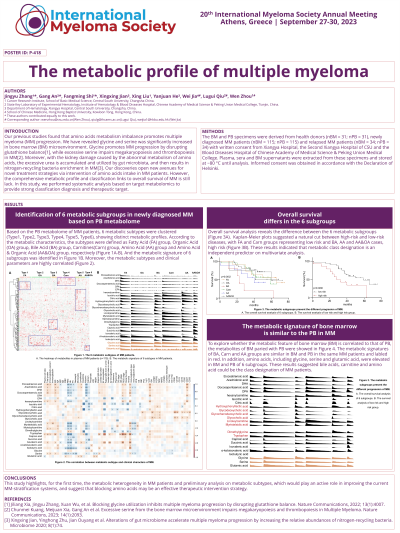Myeloma Microenvironment and immune profiling
Poster Session 3
P-418: The metabolic profile of multiple myeloma
Friday, September 29, 2023
1:15 PM - 2:15 PM EEST


Wen Zhou, PhD
Xiangya Road110# Changsha, Hunan Province, China
Cancer Research Institute, Xiangya School of Medicine, Central South University, Hunan, China (People's Republic)
Introduction: Our previous studies found that amino acids metabolism imbalance promotes multiple myeloma (MM) progression. We have revealed glycine was significantly increased in bone marrow (BM) microenvironment and blocking glycine utilization inhibits MM progression by disrupting glutathione balance. And excessive serine from the BM microenvironment impairs megakaryopoiesis and thrombopoiesis in MM. Moreover, with the kidney damage caused by the abnormal metabolism of amino acids, the excessive urea is accumulated and utilized by gut microbiota, and then results in nitrogen-recycling bacteria enrichment in MM. Our discoveries open new avenues for novel treatment strategies via intervention of amino acids intake in MM patients. However, the comprehensive metabolic profile and classification of MM is still lack.
Methods: The BM and PB specimens were derived from health donors (nBM = 31; nPB = 31), newly diagnosed MM patients (nBM = 115; nPB = 115) and relapsed MM patients (nBM = 34; nPB = 34) with written consent from Xiangya Hospital, the Second Xiangya Hospital of CSU and the Blood Diseases Hospital of Chinese Academy of Medical Science & Peking Union Medical College. Plasma, sera and BM supernatants were extracted from these specimens and stored at −80 °C until analysis. Informed consent was obtained in accordance with the Declaration of Helsinki.
Results: Identification of 6 metabolic subgroups in newly diagnosed MM based on PB metabolome
Based on the PB metabolome of MM patients, 6 metabolic subtypes were clustered (Type1, Type2, Type3, Type4, Type5, Type6), showing distinct metabolic profiles and clinical presentation. According to the metabolic characteristics, the subtypes were defined as amino acid & fatty acid (AA&FA) group, Carbohydrates (Carbs) group, Benzenoids (Ben) group, Carnitines & fatty acid (Carn & FA) group, Amino acid (AA) and short chain fatty acids (SCFA) group, respectively.
Overall survival clinical characteristics differs in the 6 subgroups
To explore the difference between the 6 subgroups, overall survival analysis reveals that MM patients in Carn & FA group and SCFA group presented better prognosis due to rich unsaturated fatty acids. Meanwhile, MM patients in Ben group and AA group presented poor prognosis. In addition, the plasma cell ratio in BM, secretion of immunoglobulin and β-microglobulin in serum were decreased in the Carn & FA group and SCFA group, meanwhile, the hemoglobin contents in serum were increased in the group. In contrast, MM patients in the AA group presented the malignant characteristics, which suggests amino acids rather than fatty acids correlates to malignant progression of MM.
Conclusions: This study highlights, for the first time, the metabolic heterogeneity in MM patients and preliminary analysis on metabolic subtypes, which would play an active role in improving the current MM-stratification systems, and suggest that blocking amino acids may be an effective therapeutic intervention strategy.
Methods: The BM and PB specimens were derived from health donors (nBM = 31; nPB = 31), newly diagnosed MM patients (nBM = 115; nPB = 115) and relapsed MM patients (nBM = 34; nPB = 34) with written consent from Xiangya Hospital, the Second Xiangya Hospital of CSU and the Blood Diseases Hospital of Chinese Academy of Medical Science & Peking Union Medical College. Plasma, sera and BM supernatants were extracted from these specimens and stored at −80 °C until analysis. Informed consent was obtained in accordance with the Declaration of Helsinki.
Results: Identification of 6 metabolic subgroups in newly diagnosed MM based on PB metabolome
Based on the PB metabolome of MM patients, 6 metabolic subtypes were clustered (Type1, Type2, Type3, Type4, Type5, Type6), showing distinct metabolic profiles and clinical presentation. According to the metabolic characteristics, the subtypes were defined as amino acid & fatty acid (AA&FA) group, Carbohydrates (Carbs) group, Benzenoids (Ben) group, Carnitines & fatty acid (Carn & FA) group, Amino acid (AA) and short chain fatty acids (SCFA) group, respectively.
Overall survival clinical characteristics differs in the 6 subgroups
To explore the difference between the 6 subgroups, overall survival analysis reveals that MM patients in Carn & FA group and SCFA group presented better prognosis due to rich unsaturated fatty acids. Meanwhile, MM patients in Ben group and AA group presented poor prognosis. In addition, the plasma cell ratio in BM, secretion of immunoglobulin and β-microglobulin in serum were decreased in the Carn & FA group and SCFA group, meanwhile, the hemoglobin contents in serum were increased in the group. In contrast, MM patients in the AA group presented the malignant characteristics, which suggests amino acids rather than fatty acids correlates to malignant progression of MM.
Conclusions: This study highlights, for the first time, the metabolic heterogeneity in MM patients and preliminary analysis on metabolic subtypes, which would play an active role in improving the current MM-stratification systems, and suggest that blocking amino acids may be an effective therapeutic intervention strategy.
